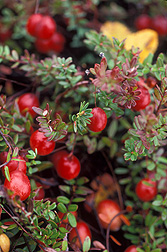| Read the
magazine
story to find out more.
|
| 
The American cranberry has changed little in 400
years, but ARS researchers have bred an experimental line with a healthy dose
of readily absorbable antioxidants. Click the image for more information
about it.
|
|

|
New Cranberry Packed with Health Features
By Rosalie Marion
Bliss
January 8, 2008 Juice drinks, saucy relishes and
dried fruit products may one day boast a new cranberry variety with a readily
absorbable dose of healthful antioxidants. Agricultural Research Service (ARS) scientists and colleagues are using
traditional breeding methods to suit up a wholesome new cranberry line with
just such a genetic trait.
Plant pathologist
James
J. Polashock, with the
ARS
Genetic Improvement of Fruits and Vegetables Laboratory, and Nicholi Vorsa,
with the Philip E. Marucci Center
for Blueberry and Cranberry Research and Extension at
Rutgers University, are collaborating on
the project. Both scientists are located at the center in Chatsworth, N.J.
Since brightening up the first Thanksgiving celebration nearly 400 years
ago, the typical American cranberry variety has only recently been bred to
develop hybrids. The team found an attractive cranberry species from Alaska
that is genetically similar enough to the American cranberry to produce fertile
progeny.
The Alaskan species is also attractive because some of the fruit's many
healthful chemical compounds—called anthocyanins—are glucose-linked.
In nature, most anthocyanins are bound to sugars. Those that are bound to
glucose sugar are relatively high in antioxidant capacity and are well absorbed
in the human gut. In contrast, the anthocyanins found in the American cranberry
are mainly bound to other kinds of sugars, so they are less easily absorbed.
The researchers found that, compared to the typical American cranberry's
anthocyanins, which are 3 to 5 percent glucose-linked, the anthocyanins in
hybrids from the first breeding cross were 50 percent glucose-linked.
The progeny of these crosses deliver two benefits: the proanthocyanidins
long known for inhibiting bacterial E. coli from sticking to the lining
of the urinary tract, and higher amounts of the potentially well-absorbed
antioxidative anthocyanins, according to Polashock. The next step is to move
the traits for glucose-linked anthocyanins from the experimental cranberry line
into a horticulturally acceptable variety that can be used by growers for
market.
Read
more about this research in the January 2008 issue of Agricultural
Research magazine.
ARS is the U.S. Department of
Agriculture's chief scientific research agency.